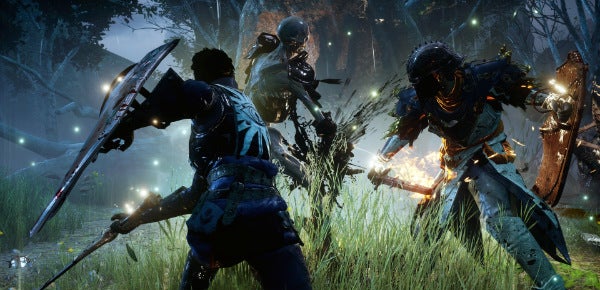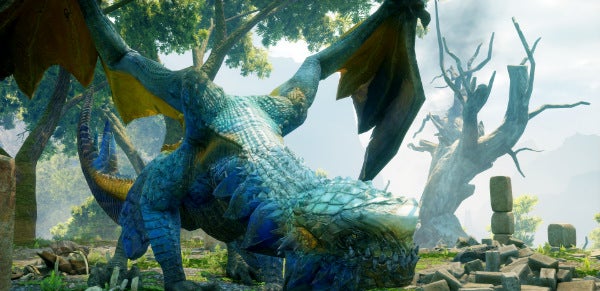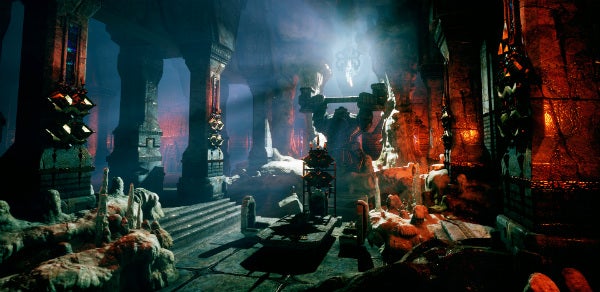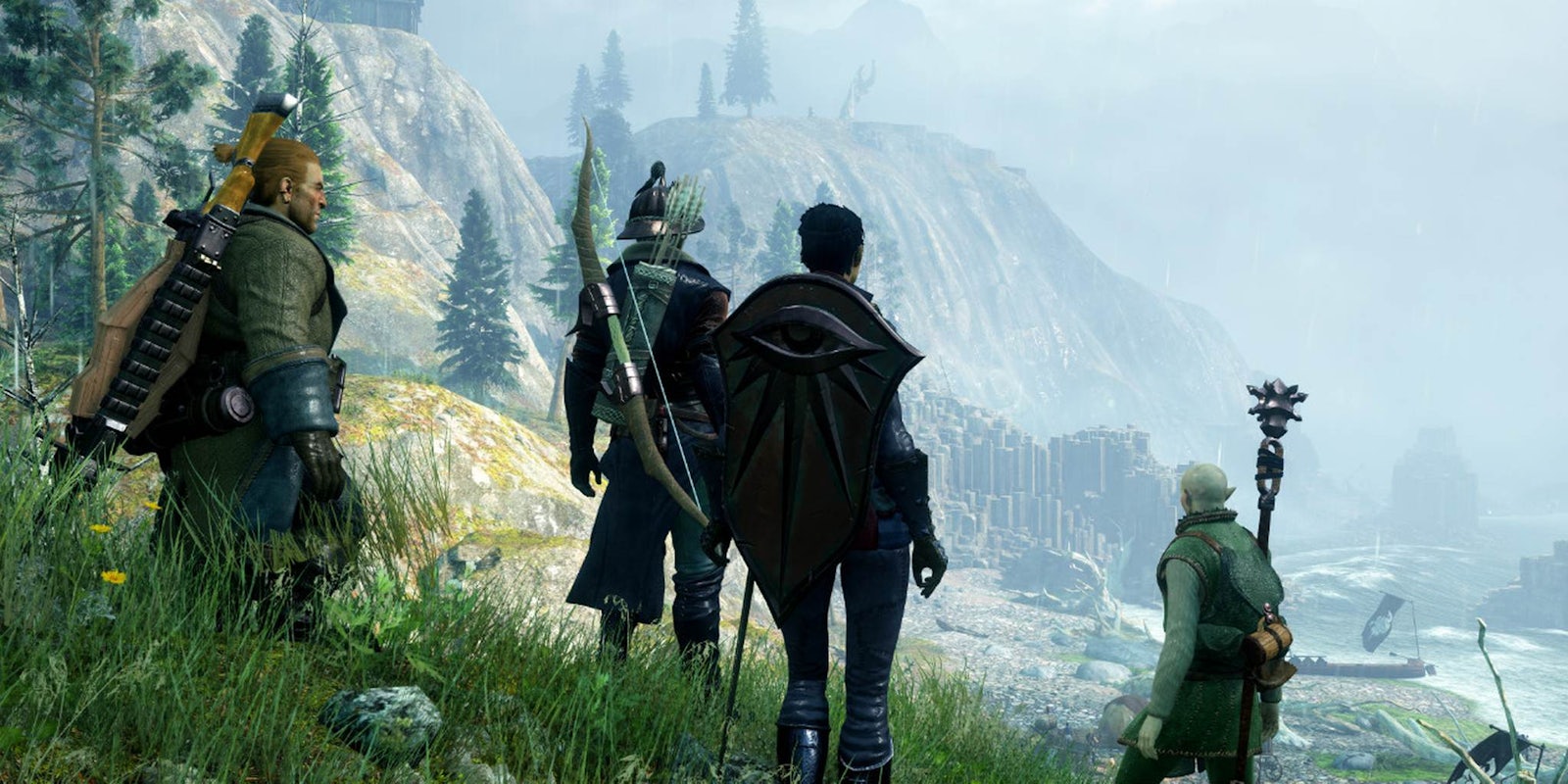If you are a Dragon Age fan and haven’t secured a copy of Inquisition yet, correct your oversight immediately.
I decided how I felt about Dragon Age: Inquisition the day I turned the game on just so I could listen to the theme music playing on endless loop over the splash screen. The sweeping notes, sharp horn blasts, and choral accompaniment of the Inquisition theme combine into a martial anthem, a march to blood and glory. I had other things to get done that day before I could jump back into the game, and the theme music provided a comforting sense of delayed gratification by reminding me precisely what I’d be returning to.
The music is bigger and more vibrant than the theme to either previous Dragon Age game, and is therefore a metaphor for the entirety of Dragon Age: Inquisition. BioWare developers during the pre-release marketing campaign for Inquisition had been tossing around a figure of 200 hours’ worth of content. In fact, because the previous two Dragon Age games were very different from one another, I had no idea what to expect out of Inquisition, other than how large it would be.
Dragon Age: Origins was massive in scale. The title referred to a plethora of unique, hours-long origin stories for the game’s hero, depending on how the player chose to depict the protagonist. The story took place across the entire Kingdom of Ferelden. The combat was stately and turn based, and engendered a slow, deliberate style of play.
Dragon Age II players could choose a gender and class for their hero, but they were always human, with the same backstory. The plot concerned the fate of a single city, and focused more on intimate relationships between characters. The combat, while still offering the ability to pause the game and issue orders to individual party members, was as much or more about mashing the attack button as anything else.
Dragon Age: Inquisition takes the world-building of Origins, meshes it with everything good about the party banter and combat system introduced in Dragon Age II, and marries it all to a more guided version of the open worlds popularized by the Elder Scrolls and Fallout series. Inquisition also does such a good job weaving the previous two Dragon Age games into its narrative that I’d swear all three games were written in their entirety prior to the release of Origins.

The overarching plot of Dragon Age: Inquisition felt much simpler and less interesting to me than those of Dragon Age: Origins, or Dragon Age II. There’s a sense of keeping Inquisition accessible to fresh audiences at work here. Even correcting for that need, I felt something was missing from the broad strokes.
Dragon Age: Origins was about the Blight, a literal eruption of evil that takes place on a regular basis when monsters called Darkspawn erupt out of the dwarven Deep Roads running underneath all of Thedas. The Darkspawn can only be stopped by the sacrifice of the martial order called the Grey Wardens. Dragon Age II was ultimately about the explosion of a centuries-old conflict between the Mages of Thedas who draw their power from a demon-infested dimension called the Fade, and the Knight-Templars sworn to prevent the Mages from being possessed by demons by killing the Mages if necessary.
Dragon Age: Inquisition heavily incorporates both those sources of lore into the game, but you could sum up the plot as “Evil Bad Guy wants to destroy the world.” The brilliance of the writing in Inquisition lies not in the overarching plot, but rather in the way the story draws together all the threads, and I mean all the threads, of the previous two Dragon Age games. I have never played a game that so deftly draws upon the plotlines of previous games in a franchise to shape its narrative, at once acknowledging old stories without feeling stale, and casting back to lore without feeling self indulgent.
The main quest line took me about 60 hours to complete, so call that a bare-bones playthrough, with no more exploration than was absolutely required to reach the end game, very little indulgence in side quests, and no long conversations with party members. Based on the other 20 hours I took to sample as much of that side content as possible, Bioware’s estimate of 200 hours’ worth of content sounds reasonable. To put that another way, Dragon Age: Inquisition has almost 140 hours’ worth of side content and fan service.
The story is the most difficult thing to talk about, because were there ever a review where spoilers are a mortal sin, this is it. I will say that I spent several hours digging into the Journal and Codex entries in my playthroughs of Dragon Age: Origins and Dragon Age II, to try and reconstruct all the choices I had made in those games. I used the information to generate a World State file using the Dragon Age Keep, which I then imported into my playthrough of Dragon Age: Inquisition, and there were only a handful of times where I felt anything I had done in either of the previous two games mattered.
What is more important narratively to Dragon Age: Inquisition than attachment to any characters, is intimate knowledge of the background of the world of Thedas. There are moments of crushing drama that will be entirely lost on franchise newcomers, as well as decisions of huge importance that will probably feel like coin-flip propositions. Part of me wishes that Inquisition had done more to give weight to those decisions independently of whether players did any side questing, or indulged in any ultimately extraneous conversations with party members, or knew anything about the previous two games.
That said, my overwhelmingly positive feelings about Inquisition are largely informed by the fact that I think it functions so well regardless of whether the player cares about the lore of Thedas, or returning characters from previous Dragon Age games, or romancing anyone, or not. The various systems in play are so masterfully crafted that any fantasy RPG fan is remiss not to play Dragon Age: Inquisition, to imagine how the genre may evolve as a result of what this game accomplishes, even if they don’t care very much about the story.

Dragon Age: Inquisition is not properly an open world game like The Elder Scrolls V: Skyrim or Fallout 3. Inquisition has a world map used for navigation, just like the previous two Dragon Age games. The areas accessed through Inquisition’s world map are huge, however, and this hybrid of proper open-world design and traditional partitioning of RPG content offers the kind of diversity of environment you rarely get from a true, open-world game.
Fallout 3 is a wasteland. Skyrim offers the variety of environments you’d expect in Scandinavia. Dragon Age: Inquisition, on the other hand, takes place on rain-battered northern coastlines and snow-covered mountains, in dense jungles and rolling plains and hilly forests, and in sand-blasted deserts practically devoid of life, or arid regions dotted with scrub brush and teeming with desert animals.
Inquisition offers adventures in fetid swamps, underground dwarven ruins, the opulence of a royal court, and millennia-old elven temples. And those are just the areas I had time to open up and explore. I think I missed a few. The variety of environments is amazing, each crafted with as much stunning attention to detail as the next. I don’t think BioWare could have done a better job of making players feel like they were truly adventuring across the entirety of Thedas.
I’m a huge fan of the way Skyrim and Fallout 3 invite intimate exploration to make sure you don’t miss anything. I also get pissed off when I finish one of these games and later realize that I missed something because I didn’t go to the right place. Inquisition gives you the best of both worlds, breaking the environment down into sizeable chunks that are easy to explore inch by inch, if you feel so inclined, rather than tossing you into the deep end to hope that you find everything.
The compromise struck by Inquisition in terms of size vs. accessibility is perfectly expressed by the search tool. It operates like a radar ping, highlighting herbs to be collected, rocks to be mined, or loot to be gathered, within the radius of the search area. It’s a middle ground between the way previous Dragon Age games made items insultingly easy to find, usually with motes of gold floating above them, and the way Skyrim or Fallout 3 require you to manually search everywhere for things, with no assist whatsoever.
Inquisition introduces mounts to the Dragon Age series. I had figured they would be an optional convenience I might eschew in favor of spending more time intimately exploring the landscape. Not to take anything away from those explorations, but some of the maps are so colossal that I was downright thankful BioWare gave my character a horse to ride, so I could get everywhere I needed to be and do everything I wanted to do in good time.
The adventure areas in Inquisition are gloriously lousy with campsites and landmarks to claim, and side quests to take from NPCs. Devices called Oculariums highlight the locations of magic shards to collect (I won’t spoil why you want to collect them), and Astrariums use constellations as puzzles to point the way at hidden treasure caches. Fortress Keeps wait to be conquered. There are even treasure maps to find and translate.
In fact, the only thing I was ever able to find in Inquisition purely by scouring the landscape, without any substantive clues or other aids, was a high dragon. There are 10 high dragons to find and kill in Inquisition, and I only had time to find one during my review playthrough. This will be the first thing I correct as I continue playing the game. Killing a dragon in Inquisition was one of the first times I genuinely felt accomplishment at killing a dragon in a video game. High dragons in Inquisition demand respect, and I appreciate that.
The combat system in Inquisition allows fans of either previous Dragon Age game to have their cake and eat it too. When the battle is in your favor, allowing AI routines to control your other party members while you run around bashing things and throwing special abilities works fine. When the odds get rough, the tactical mode offers a third-person view of the action, with free camera positioning to view the battlefield, select individual party members, and issue orders. And the innovation offered by Inquisition blurs the line between the two modes, by allowing players to manually advance time while in tactical view to see how orders play out.
Previous Dragon Age games had crafting systems only in spirit, and potions and runes and such were the extent of what players could make or have made for them. Inquisition has a proper crafting system, where players gather metal, leather, and clothing material to create weapons and armor, and attachments for those items, for potentially every character class and weapon specialization in the game. The new system revolves around schematics players can buy from merchants or earn as loot. The quality of the item is determined by the quality of the components the player drops into the schematic.
I say this as someone who habitually spends way too much time crafting in any role-playing game that has the option. Crafting has never mattered so much to me, in practical terms, as it did during my playthrough of Inquisition. In my experience crafting systems are usually a grind, pounding out hundreds of lower-level items to rank up skills in the hope that, at some point, I’ll be able to craft a piece of armor or a weapon that is clearly better than anything I can find out in the world. And sometimes, I get bored before I have enough skill or the right materials to do so.
When I finished my playthrough of Inquisition for this review, almost all the weapons and armor my four party members were wearing was crafted, and vastly superior to item drops I’d found while adventuring. Inquisition makes it easy (perhaps too easy) to satisfy players who enjoy deciphering labyrinthine crafting systems, especially in an MMO so they can be the only crafter who knows how to make and sell the ultra-rare Super Shiny Sword of Kill Everything.
As long as you gather your materials from high-level areas, and have Masterwork-level schematics, you are good to go for producing crafted gear you are actually going to use. When I discovered that first high dragon and decided it was time to go hunting, I specially crafted an entire set of gear for the dragon slaying party I put together. I have no doubt that had I tried to rely on items I’d purchased from merchants or found while adventuring, that dragon would still be stomping around.

Defeating the Evil Bad Guy who wants to destroy the world necessitates the cooperation of the warring factions of Thedas and the elimination of its worst troublemakers. This meta-game to tame and organize Thedas under the banner of the titular Inquisition is largely played out on a huge campaign map that covers the Kingdom of Ferelden on the east, and the Empire of Orlais on the west.
Unlocking areas to explore on the campaign map requires Power. Power is a resource earned by completing main quests and side quests, closing the rifts in the Fade that are popping up all over Thedas, or claiming outposts and Keeps for the Inquisition, just for starters. The Power system is like an open-ended inducement to engage in something other than the main story missions, which also require Power to unlock. The more you explore, the more Power you earn, and the more exploration beyond the main story missions you can do.
The Inquisitor (read: you) is served by a War Council composed of an Ambassador, Commander, and Spymaster, who can undertake missions assigned to them on the campaign map. The missions are completed in real time and can range from something as simple as gathering coin and crafting materials for the Inquisition to launching political and military campaigns to gain allies and destroy enemies.
Inquisition perks are bonuses that are unlocked as the player completes quests and increases the Inquisition’s Influence score. Your Commander can provide bonuses to combat training or unlock new equipment schematics. The Ambassador can inspire merchants to offer discounts or make rare items available. The Spymaster can offer increased lockpicking skills for rogues or provide reconnaissance that reveals new areas on the campaign map. Inquisition perks can also assist in the role-playing aspect of Inquisition by opening up unique dialogue options across the entirety of the game. And as you recruit people you meet in adventure zones as Agents for the Inquisition, this unlocks further perks.
Inquisition’s cooperative multiplayer mode is thematically tied to this campaign map, as well.
You play as one of the small teams dispatched on missions by the Inquisition’s Commander and Spymaster. There are 12 different character archetypes to choose from, only some of which are unlocked at the start of the game. The remaining choices are unlocked by either looting certain types of armor, or crafting it..
Inquisition’s co-op mode features 10 different tile sets (read: dungeons) set in one of three different environments, with three different enemy factions to face. The difficulty is clearly optimized for four players, and it’s not easy. Balanced party composition, i.e. always having at least one warrior, one mage, and one rogue on hand, can make or break a co-op mission, and there’s no pausing to tactical view in co-op. Coordination is done only the old-fashioned way—communicating in voice chat.
Co-op characters earn experience, unlock new abilities, earn gold, and accrue loot just like characters do in the single-player campaign. Weapons in co-op mode can be salvaged for raw materials, which can then be used to craft new items. Players can use gold earned in game or platinum purchased with real-world currency to buy chests that contain random items and potions to equip their characters.
I think the slower, more deliberate pace and brutal difficulty of Inquisition’s co-op mode are going to make it a harder sell than Mass Effect 3’s popular co-op mode, which is more action based. I also think the required depth of planning and tactics in Inquisition’s co-op mode are going to be really satisfying for players who are willing to think as a group, rather than seeking individual glory.

Dragon Age: Inquisition marks the first time that I wish a developer had decided to abandon the PlayStation 3 and Xbox 360, and focus entirely on PC and the new consoles. As great as Dragon Age: Inquisition is, there were times when I wondered if I were seeing the hobbling results of needing the core experience to work on outdated hardware.
Collision issues, like a character’s chin phasing through their breastplate armor when the character nods, or the hilt of a sword scabbard phasing through their wrist when the character puts their hand on their hip, or the bottoms of a character’s feet phasing slightly into the ground when the environment is not level, are legion.
In a day when photorealism is no longer just a buzzword, some of the mouth animations in Inquisition felt downright terrible. I could forgive the same thing in Call of Duty: Advanced Warfare because it’s a game about shooting things. In a role-playing game like Dragon Age: Inquisition, however, nailing the subtlety of characters’ faces is a must.
I only noticed these things during cutscenes and dialogue sequences in adventure zones. By and large the visuals on the Xbox One, particularly the particle effects during fight scenes, are amazing. The first time you snap into tactical view, if there’s an explosion or smoke on the screen, you may keep the game paused a lot longer than you need to just to look at how pretty everything is.
While I did hate seeing a Qunari’s horns phasing through the back of a chair as he turned to face me during a cutscene, I offer these observations mostly by way of musing as to what BioWare will be able to accomplish when they can, finally, cast aside the old hardware and focus entirely on what high-powered machines can uniquely accomplish compared to their predecessors.
I obviously can’t talk specifics, but I’m pleased to report there is no narrative land mine waiting for you at the end of Dragon Age: Inquisition, as there were at the end of Dragon Age II and Mass Effect 3. The only problem I can see anyone having with the ending of Inquisition is just how neatly, cleanly, and safely it wraps up the narrative.
When the end credits finish rolling, however, you can stand in front of that campaign table with your War Council and issue new orders, setting out on all the adventures you left incomplete before triggering the final fight with the Evil Bad Guy. Because even if the world is safe from destruction, the nobles of Thedas are still plotting, the Darkspawn are still running through the tunnels of the Deep Roads, and there’s still work to be done for the Inquisition.
Dragon Age: Inquisition will be released on PC, PlayStation 3, PlayStation 4, Xbox 360, and Xbox One on Nov. 18.
Score: 5/5
Disclosure: Our Xbox One review copy of Dragon Age: Inquisition was provided courtesy of Electronic Arts.
All images via Bioware



